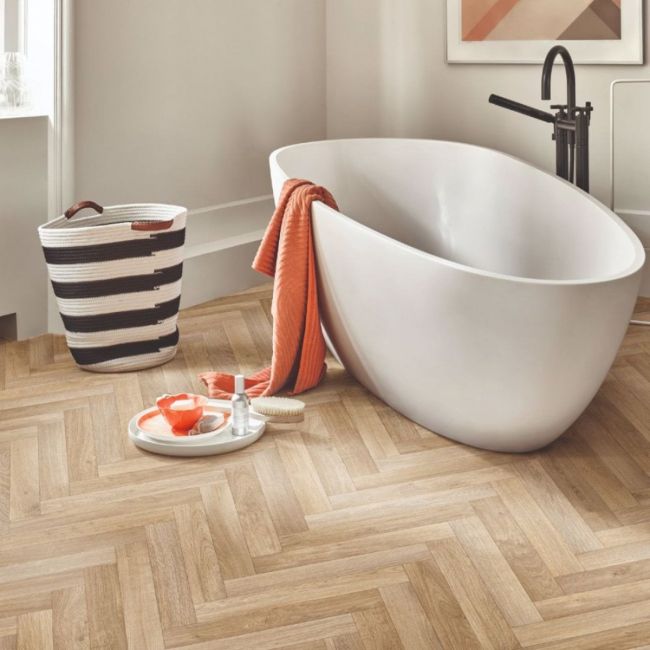
The flooring is occasionally disregarded because it is typically not the most expensive component of a bathroom makeover if you are remodeling it on a limited budget and are constantly looking for ways to save money. If you carefully analyze your flooring alternatives, you might be amazed at the savings that can be achieved. Although many flooring options may be used in bathrooms and yet meet the requirements for humidity resistance, slip resistance, and long wear, some of the standard choices can be much more expensive than you might expect. Natural stone, for instance, is a popular option but can be expensive.
Luckily, there are several affordable solutions for remodeling your bathroom floor. Options include modern vinyl flooring, porcelain tile, or simple painting of a timber floor. In this article, you will find out the budget-friendly bathroom options available for you.
1)Standard Vinyl Flooring
Vinyl flooring is rather simple to install, affordable, and low maintenance. Nearly any color or pattern you can think of can be printed on it. This makes it the ideal option for consumers on a tight budget who want to update the design of their bathroom without going overboard. Vinyl is a great waterproof bathroom flooring option because it is highly durable and water resistant. You can choose dark grey vinyl flooring for your bathroom if you want a more sophisticated look.
However, vinyl has a few disadvantages. Low-quality materials, though they may be relatively affordable, could contain components that, when put with a full-spread adhesive, might release volatile organic compounds into the air for a while afterward. The lifespan of a vinyl floor installation, even when well maintained, is often no longer than 10 years.
Standard vinyl flooring comes in two different varieties, sheet vinyl, which frequently can cover a whole bathroom floor in a single, unbroken sheet, and vinyl tiles, which are glued down in separate pieces measuring 12 to 16 inches square. Because sheet vinyl has fewer, if any, seams through which water can seep, it is a superior choice for bathrooms. In a bathroom, though, vinyl tiles still function fairly well.
2)Linoleum Flooring
An older variety of resilient flooring is linoleum. Linoleum has made a comeback after once being mostly replaced by vinyl floors. Homeowners who care about the environment are drawn to it because it is a natural material composed primarily of linseed oil. Although linoleum shares many of the same advantages as vinyl, it might have a mildly unpleasant odor for a few weeks following installation. Linoleum is somewhat water resistant, similar to vinyl, although sheet forms without seams are preferable for bathrooms that are frequently used.
3)Luxury Vinyl Flooring
Luxury vinyl flooring, a step up from regular vinyl flooring, is a thicker variety of semi-rigid vinyl that typically comes in planks that are put together using a "click-lock" tongue-and-groove system. Although the flooring is completely waterproof, there is a chance that water will seep through the seams and into the subfloor.
The benefit of luxury vinyl is that it comes in a variety of forms, many of which are accurate imitations of real wood, stone, or ceramics. DIYers should consider this flooring because it is reasonably simple to install.
4)Ceramic Or Porcelian
Natural clay combined with sediments is the primary component of ceramic floors. These tiles are highly prone to water damage, stains, and many other risks that a bathroom can present in its unfinished state. Ceramics that are coated, on the other hand, have melted glass poured over them. As a result, the tile is resistant to water and stains and may be printed with a wide range of hues and designs by producers.
Even though ceramic or porcelain tile is frequently thought of as an expensive, high-end flooring option, it can be surprisingly inexpensive for a small area like a bathroom, especially if you select a typical stock tile from a big-box home improvement store. Specialty tiles, such as glass or porcelain tiles with a wood look, are significantly more expensive.
5)Concrete Flooring
Nowadays in modern-styled residences, concrete is becoming more and more prevalent. Even for tiny rooms, it is surprisingly inexpensive. Additionally, the slab foundation or basement floor may already contain concrete hidden beneath old sheet vinyl or ceramic tile, depending on the design of your property and where the bathroom is located. If the old surface flooring is removed, you might discover a surface that can be repaired, cleaned, and finished to seem like a lovely polished concrete floor.
Although concrete is tough, it is also porous, so in a bathroom, it needs to be sealed with a substance that can keep stains and water out. Concrete, however, is simple to keep clean with routine sweeping and moist mopping if it has been adequately protected.



























